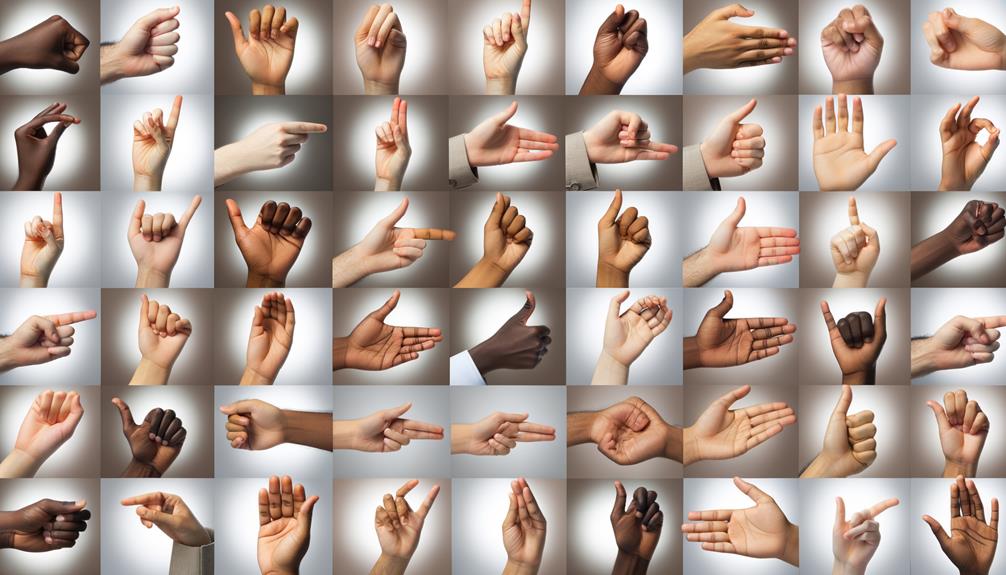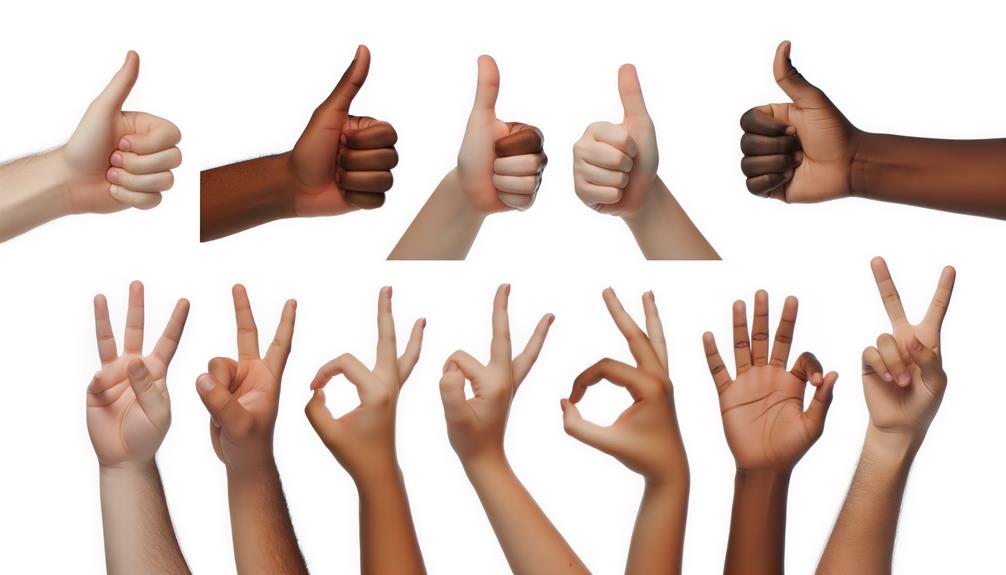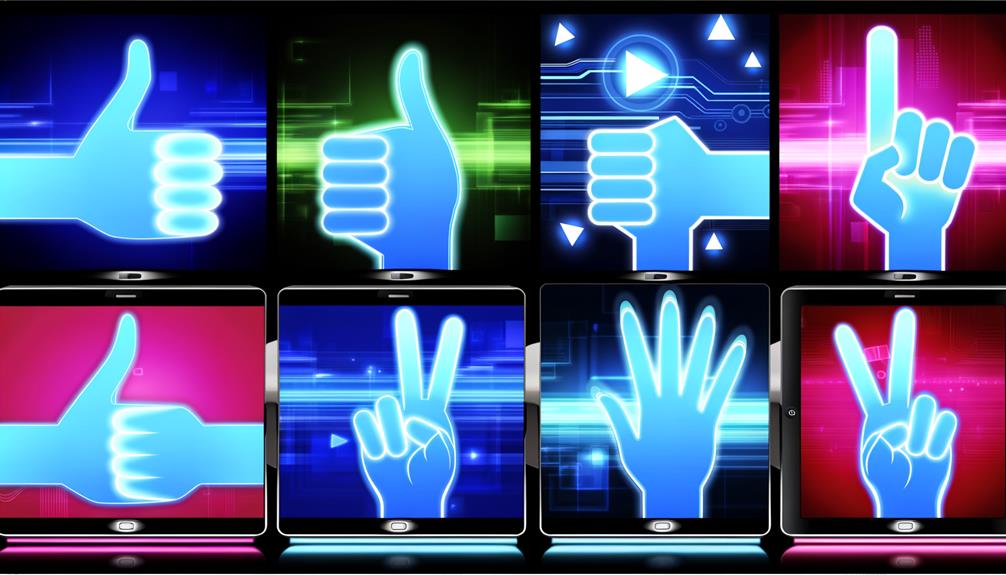What Does a Hand Symbol Mean?
Hand symbols have long been integral to human communication, transcending language barriers and conveying complex messages. Historically, handprints in cave paintings served as early self-identification marks.
Egyptian hieroglyphics, Hindu and Buddhist mudras, and Mediterranean gestures reflect rich cultural and spiritual meanings. The meaning of common gestures like the thumbs-up or peace sign varies greatly across cultures.
In politics, raised fists and V-signs symbolize unity and defiance. Modern digital communication further evolves these symbols, with emojis bridging global linguistic divides.
Understanding these nuances offers deeper insights into our shared cultural heritage and diverse expressions.

Key Takeaways
- Hand symbols convey various meanings, often dependent on cultural context and historical origins.
- Spiritual and religious hand gestures, like mudras, symbolize specific states or divine messages.
- Political hand gestures, such as the raised fist, signify unity and defiance.
- Common hand gestures, like the thumbs-up, can have drastically different interpretations globally.
- Emojis with hand symbols enhance digital communication and bridge cultural and linguistic gaps.
Historical Origins

How have hand symbols evolved through history to carry such diverse meanings across different cultures?
The historical origins of hand symbols can be traced back to early human communication methods before the advent of written language. Cave paintings in Europe, dating back 30,000 years, depict handprints as a form of self-identification or territorial marking.
In Ancient Egypt, various hand gestures were depicted in hieroglyphics, serving both religious and social functions. Similarly, in ancient India, gestures known as 'mudras' played a significant role in spiritual rituals and classical dance.
These early instances illustrate how hand symbols functioned as a universal language, transcending spoken dialects to convey complex social, religious, and cultural messages.
Over millennia, the meanings have diversified, reflecting each culture's unique context and priorities.
Cultural Variations
Across diverse cultures, hand symbols have evolved to embody distinct meanings that reflect each society's unique historical, social, and spiritual contexts.
For instance, the 'thumbs up' gesture signifies approval in many Western cultures, yet it can be deemed offensive in parts of the Middle East.
In Hindu and Buddhist traditions, the 'mudras'—ritualistic hand gestures—are crucial in spiritual practices, symbolizing a range of states from enlightenment to protection.
Conversely, the 'mano cornuta' or horned hand, often a symbol of rock music in the West, can ward off evil in Mediterranean cultures.
These variations underscore the importance of understanding cultural nuances to avoid misinterpretation and to appreciate the rich tapestry of human expression through hand symbols.
Common Gestures

In examining common gestures, the thumbs-up, peace sign, and OK gesture each carry distinct connotations shaped by cultural contexts.
The thumbs-up often signifies approval or agreement in Western societies, whereas its interpretation can vary considerably in other regions.
Similarly, the peace sign and OK gesture, while globally recognized, can possess unique implications within different ethnographic and sociocultural landscapes, highlighting the importance of understanding these symbols through a comparative lens.
Thumbs Up Meaning
The thumbs up gesture, universally recognized for its positive connotations, varies in significance across different cultures, reflecting a rich tapestry of contextual interpretations and historical evolution.
In Western societies, it often signals approval, agreement, or success. However, in parts of the Middle East, South America, and West Africa, this same gesture can be perceived as offensive or disrespectful.
The origins of the thumbs up can be traced back to ancient Rome, where it held life-or-death implications in gladiatorial combat. Ethnographic studies reveal that while globalization has promoted a more homogeneous understanding, localized meanings persist.
Therefore, the thumbs up remains a potent example of how hand gestures encapsulate complex layers of cultural identity and historical context.
Peace Sign Interpretation
Just as the thumbs up gesture carries varied cultural significance, the peace sign—formed by raising the index and middle fingers while keeping the others folded—embodies a rich spectrum of interpretations across different societies.
Originating during World War II as a symbol of victory, it evolved in the 1960s into an emblem of peace and counterculture. Its meanings can vary:
- Western Context: Commonly signifies peace, unity, and anti-war sentiments.
- East Asian Context: Often used in photographs to convey happiness and friendliness.
- Political Context: In some regions, it represents political movements or opposition.
Understanding these variations enriches our appreciation of how a single gesture can traverse cultural and historical landscapes, adapting to diverse social narratives.
OK Gesture Significance
Across various cultures, the 'OK' gesture—formed by connecting the thumb and index finger into a circle while extending the other fingers—carries multifaceted connotations that range from approval and agreement to offensive and controversial meanings. In Western societies, it is commonly understood as a sign of assent or affirmation. However, in countries like Brazil and Turkey, the same gesture can be interpreted as offensive. The cultural context plays a pivotal role in determining the meaning of this hand symbol.
| Region | Positive Meaning | Negative Meaning |
|---|---|---|
| United States | Approval, Agreement | None |
| Brazil | None | Offensive, Obscene |
| Japan | Money | None |
| France | Zero, Worthless | None |
| Turkey | None | Insult, Homophobic Connotation |
Understanding these nuances is essential for effective cross-cultural communication.
Religious Significance
Many religious traditions attribute profound spiritual and symbolic meanings to specific hand gestures, reflecting deeply ingrained cultural and theological beliefs. These gestures often serve as conduits for divine communication and spiritual alignment.
For instance:
- Mudras in Hinduism and Buddhism: Hand gestures like the Abhaya Mudra symbolize protection and fearlessness, often seen in depictions of deities and enlightened beings.
- The Sign of the Cross in Christianity: This gesture signifies the Holy Trinity and the sacrifice of Jesus Christ, used during prayers and blessings.
- Hamsa in Middle Eastern Religions: This open hand symbol represents protection against the evil eye, prevalent in Judaism and Islam.
Such gestures encapsulate millennia of spiritual practice, serving as tangible links to the divine across diverse cultures.
Political Implications

In the world of politics, hand gestures often carry significant weight, functioning as powerful tools for communication and symbolism. Politicians across cultures employ specific gestures to convey solidarity, authority, or resistance.
For instance, the raised fist has historically symbolized unity and defiance, from the Black Power movement in the United States to anti-apartheid protests in South Africa. Conversely, the V-sign represents victory or peace, immortalized by Winston Churchill during World War II.
Modern Usage
Today, various hand symbols have evolved to encapsulate new meanings and subtleties, reflecting the dynamic nature of contemporary communication across different cultures. The integration of these gestures into modern contexts reveals rich layers of cultural expression and interpretation.
- The Peace Sign: Originally a symbol of anti-war movements, it now often signifies general goodwill and harmony.
- Thumbs Up: While globally recognized as a positive affirmation, in some cultures, it can be offensive or carry different connotations.
- The Fist: A symbol of solidarity and resistance in many social justice movements, it conveys collective strength and unity.
The comparative study of these symbols demonstrates the cultural specificity and evolving nature of non-verbal communication. Understanding these aspects fosters deeper cross-cultural appreciation and interaction.
Digital Representations

The advent of digital communication has revolutionized the use of hand symbols, particularly through the widespread adoption of emojis. These virtual hand gestures, which range from the thumbs-up to the peace sign, have become integral to online interactions, transcending linguistic and cultural barriers.
Emoji Communication Revolution
As digital natives increasingly integrate emojis into daily communication, these pictorial symbols have evolved into a nuanced language, reflecting cultural shifts and bridging gaps in cross-cultural dialogue. Emojis, particularly hand symbols, serve as ethnographic markers that offer insight into societal values and interactions. Their digital representations provide a comparative perspective on non-verbal communication, highlighting both universal and culturally specific meanings.
Contextual Variability: A thumbs-up emoji signifies approval in many cultures but can be offensive in others, illustrating the importance of context.
Cultural Adaptation: Emojis are continuously updated to reflect diverse skin tones and cultural practices, promoting inclusivity.
Interpersonal Dynamics: Hand symbol emojis can convey emotions and intentions that transcend linguistic barriers, enhancing interpersonal connections globally.
This digital semiotics revolutionizes how we comprehend and communicate.
Hand Gestures Online
Digital representations of hand gestures encapsulate a rich tapestry of cultural narratives, offering a fascinating lens through which to examine the confluence of tradition and technology. These gestures, from the ubiquitous thumbs-up to the prayer hands, serve as a digital shorthand for nuanced emotions and social cues. The table below outlines some common digital hand gestures and their meanings:
| Gesture | Meaning |
|---|---|
| �� (Thumbs Up) | Approval/Like |
| �� (Prayer Hands) | Gratitude/Request |
| �� (OK Sign) | Agreement/Perfection |
| �� (Waving Hand) | Greeting/Goodbye |
Each symbol is steeped in cultural context, reflecting societal values and communication norms. Comparative analysis reveals how these digital gestures transcend linguistic barriers, creating a universal language that bridges diverse communities.
Virtual Hand Symbols
Reflecting a complex interplay between cultural heritage and modernity, virtual hand symbols serve as pivotal elements in the digital lexicon, offering a rich field for ethnographic and comparative analysis. These symbols, encoded in emojis and digital icons, transcend geographical boundaries while retaining culturally specific meanings.
For instance, the 'thumbs up' emoji, a universal sign of approval, can have varied interpretations in different cultures, from encouragement to outright offense.
Cultural Context: Virtual hand symbols often retain traditional meanings but can acquire new connotations in different digital communities.
Digital Communication: They play an essential role in non-verbal online interactions, adding layers of emotional nuance.
Comparative Usage: Cross-cultural analysis reveals both universal and divergent patterns, reflecting broader socio-cultural dynamics.
Understanding these nuances enriches our comprehension of digital communication.
Conclusion
The hand symbol, a tapestry woven with threads of historical origins, cultural variations, and religious significance, embodies a spectrum of meanings across the globe.
Its political implications and modern digital representations further deepen its complexity. Like a multifaceted gem, the hand symbol reflects the diverse human experiences and contexts from which it arises, offering rich insights into societal values and communication practices.
This emblematic gesture remains a powerful tool for expressing nuanced human interactions.





